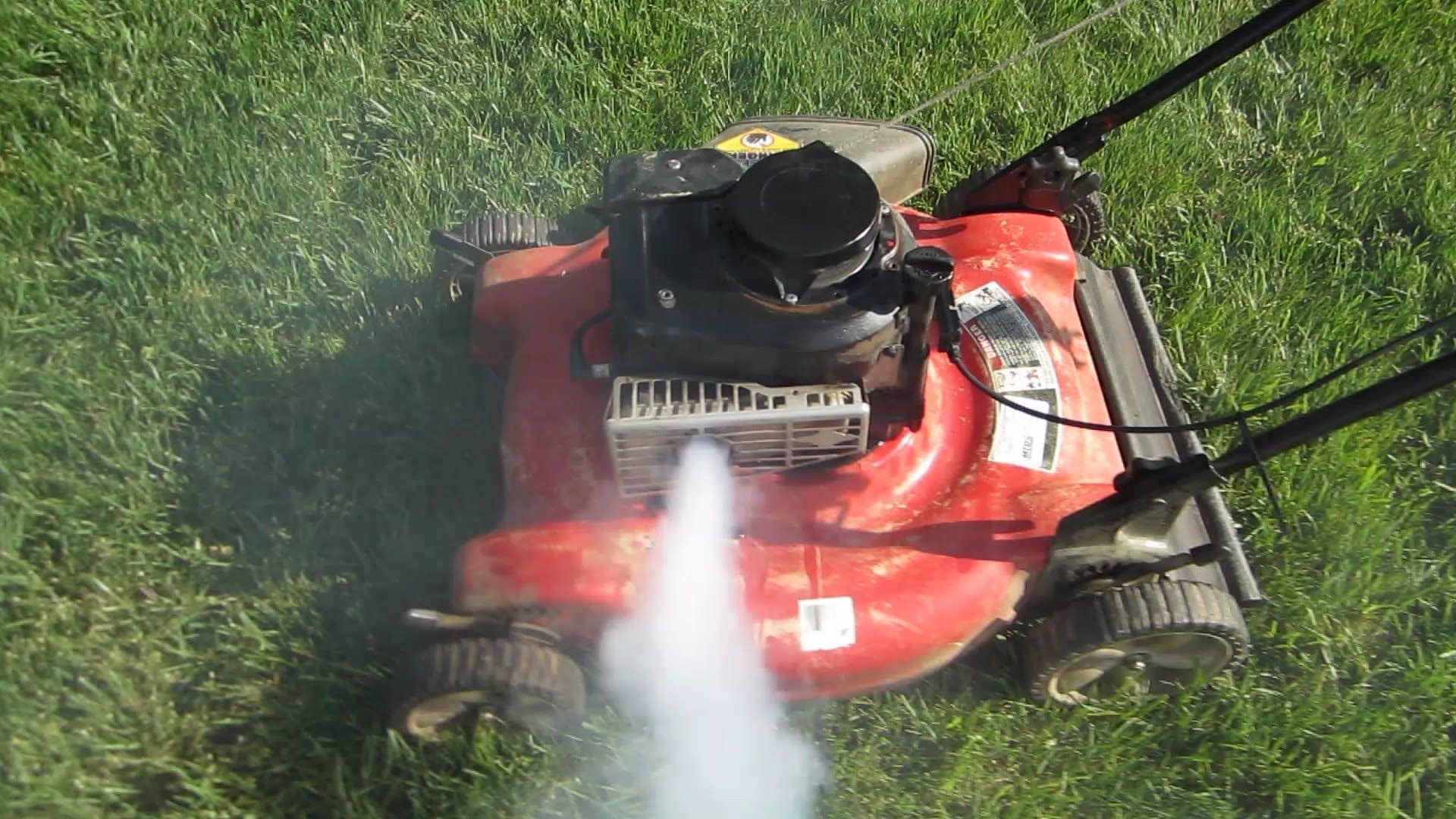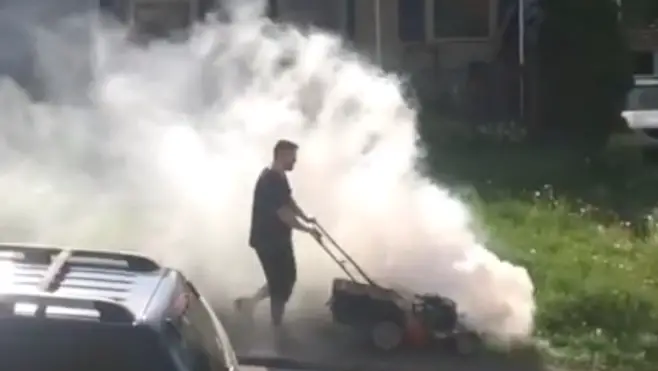Noticing smoke from your engine is definitely not a good sign. This is especially so if you don’t know how to fix a smoking lawn mower. Blue or white smoke may indicate that oil is being burnt along with too much fuel.
When it comes to black smoke, it means that the engine is running rich, and the carburetor isn’t getting enough air due to a dirty or clogged air filter. But relax, here’s how to identify the issue without the help of a professional.
1- White / Blue Smoke?
Among the three colored smoke, your mower may create white or blue smoke- the most common. It will most of the time go away on its own after a while from running until the smoke clears out. It’s a sign that your lawnmower’s engine is burning oil, which is the main reason.
This can result due to any of the following reasons :
– Tipping your mower on its side or using it at a steep slope
If you tip your lawnmower the wrong way so you can take a look under the deck or replace the blades, it can cause the engine oil to make its way into the cylinder and start burning.
Also, you might have used it at a surface or angle that is too steep. Both of these situations may happen in the bottle filling up with oil and white or blue smoke produced from the exhaust.
What To Do
If your mower has begun smoking after being tipped over, you can get rid of the white smoke by only letting the mower run on idle until the spilled oil clears.
Similarly, it is best to evade using your mower at a surface with a slope of more than 15 degrees. Check your owner’s guidebook to find the best way to reduce the risk of oil leaks if you frequently tip the mower for cleaning or maintenance.
– Overfilling the engine with oil
Lawnmower engines usually require a little over half a quart, so sometimes it’s easy to overfill them. While a lawnmower engine with less than an average amount of oil is going to face a lot of friction. On the other hand, a mower with too much fat will start leaking, and when the engine gets hot, it will exhibit smoke as the oil burns.
So ensure you didn’t overfill the mower by checking the oil level with the dipstick located in the reservoir. I wrote a small guide down below – shows you how to check and change your lawnmower’s oil.
What To Do
Simply lift the dipstick cap, wipe off the stick with scrap, and reinsert it into the reservoir. Then raise the dipstick once again and determine the oil level depending on the recommended “fill” line on the stick.
If the level is very high, pour the oil, then refill the reservoir with it. Keep on adding small amounts of oil until the scale matches the recommended “fill” line.
– Damaged head gasket
A damaged head gasket is much less likely, but it will produce lots of smoke. Unlike previous solutions, this would be a cause of worry or require you to do a severe repair.
It is a metal seal used to keep the engine locked off, located between the cylinder head and the cylinder block of an engine. Its role is to seal the combustion chamber. If your lawnmower has a cracked head gasket, then the smoke won’t disappear if you pour the mower for a while as it does if it’s tipped on the side or overfilled with engine oil.
When it is not sealing the cylinder head well, oil can leak into it from the crankcase and start burning. You can also hear the noise of smoke being blown from the leaking gasket and loss of compression, which generates low power output from the mower.
What To Do
Head gasket is found in the OHV engine, and if it is damaged or starts leaking, the only way you can fix it is by placing a new head gasket in.
First, you will have to remove the sparkplug wire and remove the bolts that contain the cylinder head over the engine block using a socket.
Then, You will find the damaged gasket on the engine block where the cylinder head connects. Take it off and use a tool to scrape off any hard to remove debris, but be careful not to break the smooth surface when scraping off the pieces.
Finally, place the new gasket on the engine block. Place the cylinder head back in position before bolting it back onto the cylinder head and putting the sparkplug wire on the sparkplug.
– Failed piston rings
A damaged piston ring is probably the worst one of all the previous reasons. It is typically seen in older worn out lawnmowers or if the mower is poorly controlled. When these piston rings crack, there is nothing to hold the engine oil from accessing the combustion chamber. They may get damaged due to :
A dirty or worn out air filter may let dust and other shreds stuck in the combustion chamber and harm the piston rings.
Not replacing the engine oil on time will cause inadequate lubrication and damage the piston rings.
What To Do
Failed or worn piston rings are the end, sadly it requires a complete engine rebuild. It is best installing a new engine – a cheaper option, and it comes with a guarantee.

2- Black Smoke?
A lawn mower engine will blow black smoke when the fuel and air mixture are too rich. It’s an indication that there isn’t sufficient air, combustion is incomplete, and the unburnt fuel in the combustion chamber converts to smoke. This can happen to your machine due to the following reasons:
– Choke Stuck On
When you light a mower, the choke closes so that the carburetor sends a frequent gasoline mixture to the cylinder. Once then motor starts, the choke opens since that rich mixture is no longer necessary to keep the engine running. If the choke sticks, it declines to open, and the gas mixture continues to be too oily.
What To Do
Check any linkages to the choke to make sure they are running correctly, and the choke is free of dirt and debris.
– Blocked Air Filter
Another reason for faulty air in the combustion chamber is a dirty air filter. When the filter gets clogged or dirty, it prevents sufficient airflow into the carburetor. So it cannot pull in the required volume of air, which makes the mix too productive.
What To Do
Foam filters are generally washable with soap and water and recharged with a light coating of fresh engine oil before reinstalling. Paper filters, however, are disposable and must be replaced instead of cleaned. Or you can usually get it going again by cleaning or replacing the spark plug, and the mower will start operating.
– Faulty Carburetor
Small motor carburetors have either two or three adjustment pins — one is for adjusting the idle speed. The other one is for adjusting the fuel mixture ratio. Inside the carburetor pot, a float rises and falls with the quantity of gasoline in the carburetor. If the float is sticking or has revealed a hole, it cannot regulate how much gas enters the carburetor.
When the engine generates black smoke, it could be because the low-speed screw – marked ‘L’ on the majority of mowers – is open too far.
What To Do
Locate the carburetor’s adjustment screws, which are usually under the air filter, and use the low-speed screw 1/4 to 1/2 turn clockwise with a screwdriver to produce a leaner fuel mixture. When you precisely adjust it, you’ll probably notice that the mower’s engine sounds better because it’s blazing fuel more efficiently.

How to check and change your lawn mower oil?
When To Change The Oil?
When you buy a new lawn mower, one of the primary questions is how often you have to change the oil. In general, every model comes with a guidebook where you can tell the most specific timing for this plot.
It can also help you how to fix your smoking lawnmower. Still, I can tell you that most of them need the oil to change after every 20 to 50 hours of work on average. Don’t forget to replace the oil in a new lawnmower engine after the first five hours of working.
Another thing, check the oil every time you use it. Harsh conditions such as wet grass, heavy dust, high temperatures, and rough or hilly terrain, may increase the frequency of needed oil changes.
How to Check Oil Level?
It is a shared problem that users will accidentally put in too little (or too much) engine oil. If they then try to start the mower, the engine can seize. And if you’ve just bought a new lawnmower, this will be absolutely disturbing.
Step 1
Clean the area around the fill tube cap with a rag. This stops dirt and grime from getting inside the crankcase when you lift the mower’s fill tube cap.
Step 2
Remove the cap from the fill tube. The dipstick connects to the bottom of the lid. Wipe it with a clean rag.
Step 3
Enter the dipstick back into the fill tube, and turn the cap clockwise. Check where the oil comes up to. The standard should be near the upper hole or fill line on the dipstick.
Step 4
Too much or too limited oil can cause significant damage to the engine. If needed, top up your oil to the correct level and then recheck using the dipstick. Once the level is perfect, replace the dipstick and tighten. Now you can operate your mower.

How to Change Lawn Mower Oil?
1 ) Prepare For The Oil Change
Before discarding the oil from your unit, you need to warm up the engine for at least 15 minutes. Clean around the oil fill area to remove all dirty debris. After that, you will need a pot or any other container to catch the old oil extracted from your mower.
2) Draining The Oil
If your lawnmower has a drain plug, you just need to move and drain it. Otherwise, remove the plastic oil fill cap, lean the mower on one side carefully, and completely drip out into the mower’s container.
3) Replace The Oil Filter
Most of the walk-behind cord mowers don’t have oil filters at all. If your model is one of those with this filter, you should change it while replacing the oil.
4) Refill The Oil
Now, you can spill in the new, clean oil. Read your operator’s manual to select the best oil for your engine type.
Conclusion
In case the previous steps couldn’t ease how to fix a smoking lawnmower, it might have a more severe problem and require professional help.
If your mower is still under warranty, consult with the manufacturer for the nearest servicing mechanic, or poor workmanship that may garner free repairs. If your mower is not included under warranty, a decent small-engine repair shop should also be enough to get the job done.


